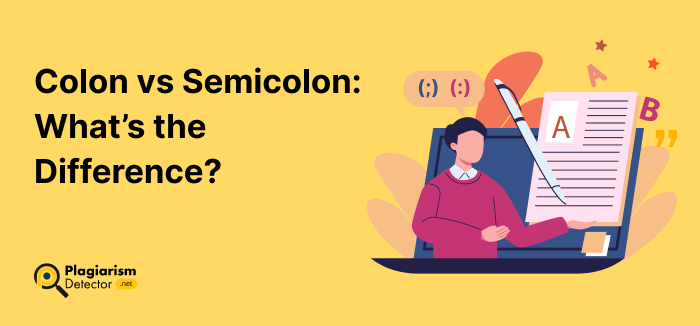Colon vs Semicolon: What’s the Difference?

Colon vs Semicolon: What’s the Difference?
Colon highlighting more information. A semicolon is useful for breaking apart items in a complicated list and connecting closely related concepts in a text.
Colon vs Semicolon: What’s the Difference?
Punctuation marks are an integral part of written communication. They tell readers about the overall tone of the text and when to stop. Therefore, punctuations act as a roadmap for them throughout the content. However, punctuation is a broad topic because there are different punctuation symbols. The colon and semicolon are two of the most puzzling ones.
Colon vs Semicolon not only sound similar, but they often confuse novice writers. As a result, beginners frequently misuse these two punctuation signs. So, if you belong to such a group, this blog is for you.
Here, we’ll take assistance from a few rules and examples to clarify the distinction between a colon and a semicolon. Besides, we’ll also share a key trick to help you when to use semicolon vs colon. So, let’s get started right away.
Colon (:)
A colon is a flexible punctuation symbol often highlighting or providing more information. That additional information closely relates to the preceding clauses. This is how the use of a colon gets justified in a text.
Various Colon Use Cases and Examples
Colon has a versatile nature. Therefore, this punctuation sign has several applications. And if you want to understand the ins and outs of the colon properly, it is essential to comprehend them. So, here are the most common use cases of the colon, along with their examples:
To Introduce a List
A colon is most commonly helpful in introducing a list. This is especially true for situations where the prior sentence is an independent clause, like the following:
Joey purchased three memory cards: 8 GB, 16 GB, and 32 GB.
In the above example, the colon indicates a list of memory cards Joey purchased.
To Emphasize
Some expert writers often consider the assistance of a colon for emphasizing a particular word in their sentence. Here is an example that describes how to do that:
There is only one thing that my parents can’t tolerate: deceit.
This example showcases the usage of the colon to emphasize the word ‘deceit.’
To Provide Additional Information
A colon can also help add extra information. That additional information is generally an example or explanation clarifying the preceding information. Here is an example of this use case:
Rachel had only one hobby: swimming.
As you can see, this example perfectly provides the required explanation about Rachel’s only hobby.
Semicolon (;)
Like a colon, a semicolon is a highly adaptive punctuation mark. However, it is often useful for two purposes: breaking apart items in a complicated list and connecting closely related concepts in a text.
Different Use Cases and Examples of Semicolon
Due to the flexible nature of semicolons, experts often use them in numerous cases. Here is a list of those applications and their relevant examples:
Connecting Independent Clauses
Independent clauses are those sentences that can also be meaningful as separate sentences. So, when it comes to connecting two independent clauses, the general convention is to use a semicolon like this:
He prefers reading; his favorite genre is science fiction
As you can see in the above example, both sentences are meaningful. But they are interlinked with the help of a semicolon.
Connecting Clauses With Conjunctive Adverbs
Sometimes, connecting two independent clauses requires conjunctive adverbs, such as accordingly, consequently, hence, however, nonetheless, rather, therefore, thus, etc. So, if you’re dealing with such a scenario, you will have to use a semicolon before the conjunctive adverb and a comma afterward. Here is how to correctly place a semicolon when connecting clauses with conjunctive adverbs:
She failed to see the step; therefore, she stumbled.
The above example demonstrates how a conjunctive adverb (therefore) has a semicolon before and a comma afterward.
Listing Items in a Complicated List
Sometimes, there are situations where a list contains internal commas. So, experts prefer using the semicolon in such situations to maintain a clear flow. Here is an example that represents the implementation of this use case:
I visited Paris, France; Rome, Italy; and Berlin, Germany.
As you can see, the above example separates the different city-country pairs and makes it easier for readers to comprehend the information.
How Can You Ensure the Correct Usage of Each?
By now, you may have understood that the rules about the correct implication of colon and semicolon are complicated. To make things easier, we have an automated solution in the form of a punctuation checker. This tool employs the training of its machine learning models and linguistic understanding techniques to analyze the missing or incorrect usage of punctuation marks carefully. Language understanding helps such a punctuation-checking utility provide suggestions according to the situation. Therefore, if you have trouble remembering all the rules and regulations about colon and semicolon, you can consider the assistance of such a tool.
Beware! Role of Punctuation Marks in Written Communication
Beware! What Are Top 10 Punctuation Marks in English Grammar?
Conclusion — Summing Up
The colon (:) and semicolon (;) are essential to written communication because they make the writing clear and effective. However, the similarity in their names and appearances often confuses people, especially beginners. The good thing is that both these punctuation marks serve different purposes. A colon helps emphasize, explain, or introduce information, whereas semicolons only connect related ideas and present complex lists. So, if you just remember this difference, you will never puzzle between these two punctuation marks.




